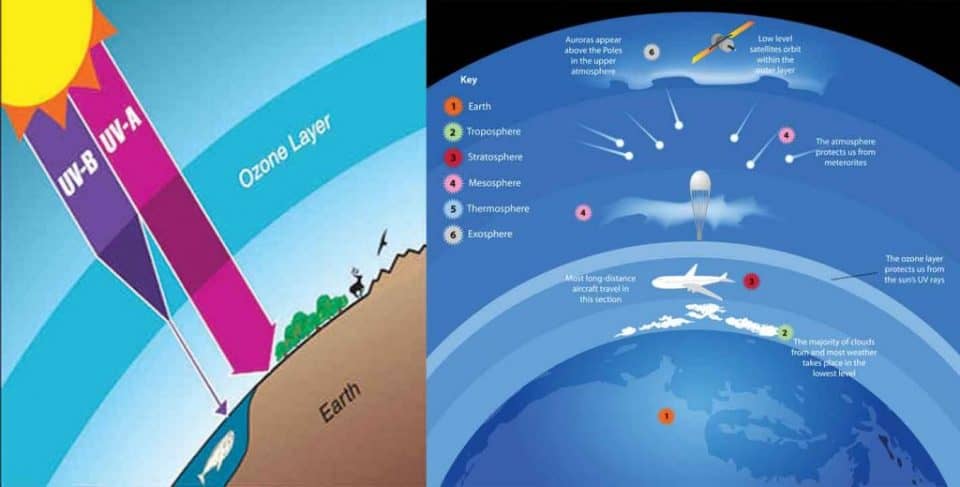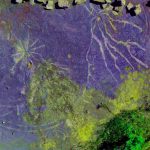– Sadia Noor Portia
– Mohammed Kaiser Ali
– Rahman Mahfuz
This was decades before a huge hole in the Ozone Layers shook the world as a rising climate crisis, because of which the storm of protest arose. If we did not observe this change in world climate, the future days would probably be warmer.
The discovery of the Ozone Hole made the world aware of the importance of the Ozone Layer, its structure and cause of destruction, and the causes of destruction.

Ozone (O3) is an Oxygen (O2) molecule that absorbs certain wavelengths of a harmful ultraviolet ray of the Sun. Its location in the atmosphere is between 20 and 30 kilometres (12 to 19 miles) from the Earth surface. Ozone creates such a layer at the stated location of the atmosphere that is helping to protect the biosphere by absorbing the harmful effects of Sun Ray. As well as preventing the warming of the earth.
The Ozone Layer is very thin and it is unstable – the ozone (O3) layer is constantly breaking and building. In fact, the Ozone is unstable, that is, it is forming and breaking, so the Ozone Layer is also unstable.
Several spices of Oxygen exists in excited states in the upper atmosphere (O*, O+, O2*) in the presence of solar radiation. These spices react differently to the formation of Ozone in the presence of other chemical agents, such as N2 or metal oxide, and Ozone (O3) is formed in the following chemical reactions:
O2 + hν (240 mm wavelength) → O + O
O2 + O + (M) → O3 + M
Where M = N2, metal oxide (acts as a catalyst present in the atmosphere). These agents reduce excess energy to stabilize ozone formation.
Ozone (O3) exists at two levels in the atmosphere. The ozone that exists at altitudes up to 10-15 km. above the earth, the surface is called Ground-level Ozone, O3 which is very dangerous air pollution and creates photochemical smog on the surface. Photochemical smog is a poisonous gas that can cause the loss of life of animals and plants.Ozone depletion gases of the ozone layer are Nitric oxide (NO2), hydroxyl radical (OH–), and chlorofluorocarbon (CFCl3) or CFC.
The chemical reactions by which these gases are destroying the ozone in the atmosphere are:
1. Reaction with Nitric oxide (NO2):
O2 + hν (240 mm wavelength) → O + O
O3 + NO → NO2 + O2
NO2 + O → NO + O2
2. Reaction with Hydroxyl radical (OH–):
H2O + hν → OH– + O–
O3 + O– → O2 + O2
O3 + OH– = O2 + HOO– (per oxide radical)
Hoo- + O– → OH– + O2
3. Reaction with Chlorofluorocarbon (CFCl3 or CFCs):
CFCl3 + hν → CFCl2 + Cl. (hv = 240 nm wave length)
Cl. + O3 → ClO. + O2
ClO. + O → Cl. + O2.
This reaction is a cyclic reaction, each reaction of Cl – radical can remove 1,00,000 Ozone (O3) molecules.
This is the latest theory for which a German and two American scientists were awarded the Nobel Prize in atmospheric chemistry in 1995. Chlorofluorocarbon (CFCl3 or CFCs) is a type of low boiling solvent synthetic gas that is used as Freon gas in the cooling devices such as freeze, air conditioner, and aerosol.

After this gas is formed, it quickly reaches in the atmosphere. Its molecules are very powerful, this gas destroys Ozone of the Ozone Layer and creates Ozone Holes through which the sun’s ultraviolet ray reaches the earth directly, which causes many complex diseases, including skin cancer, as well as earth’s temperature rising.
Chlorofluorocarbon is more responsible for global warming than other greenhouse gases, such as carbon dioxide (CO2), nitrous oxide (N2O), methane (CH4) etc. The chlorofluorocarbon molecule is very strong. One molecule chlorofluorocarbon is 3,80,00,000 times stronger than the one molecule of carbon dioxide, 15,20,000 times stronger than the one molecule of methane, 10,000 times stronger than the one molecule of nitrous oxide.
The Montreal Protocol was signed with the initiative of the United Nations in 1987 to limit the production and use of chlorofluorocarbon, along with other Ozone destroyer gases. Since then, the use of chlorofluorocarbon in the developed countries has dropped to zero now. In countries like ours, the use is gradually becoming limited.
Studies show that the shape of the Ozone Hole created at the North and South Poles have been steadily decreasing over the past two decades as a result of the Montreal Protocol. In addition, the prediction of the rise of the global temperature appears to be at least one degree Celsius cooler than the previously thought temperature by 2050.
One degree is far away. When all those decades will come where only 2 degrees will make our future generations think about it, that has not even been seen in thousands of years before. And because of this, there will be many disastrous consequences on earth, such as floods, droughts, severe warming, cold waves, cyclones, landslides, etc. natural disasters.

As a result, the ‘Montreal Protocol’ of 1989 is undoubtedly a breakthrough agreement to save the Ozone Layer. Recently researchers at the University of New South Wales (UNSW) in Australia have evaluated different climatic scenarios using simulations in conjunction with a global climate model. Where it is shown if this Protocol and its implementation did not happen, what today’s world would look like?
Their primary goal was to determine how a toxic drop of ozone-destroying chemicals influenced Antarctic’s atmospheric circulation. Through research, they envision a world where CFCs continue to grow at a rate of about 3 percenta per year – a rate that will be the condition of the world by the end of the twentieth century.
In the early 20th century, ozone-destroying compounds had a catastrophic effect on the atmosphere, especially in the lower edge of the earth. In 1985, world leaders came together to sign the Vienna Convention on the Protection of the Ozone Layer, it is a promise that would later adopt the form of a protocol designed to stop the production of ozone-destroying chemicals around the world.
Three decades later, the empty space of the layer has completely disappeared for a defensive section of the atmosphere. (Read a portion of the clip below on this topic from the Australian Academy of Sciences.)
“It was a story of tremendous success. Although a handful of miscreants are still spreading pollutants. The Protocol signed in Montreal could be an example of this. The agreement could be considered as a perfect example of what humanity can achieve for a sustainable future.”
Climate scientist Rishav Goyal from UNSW said, “CFCs gases are thousand times more powerful than carbon dioxide, so the Montreal Protocol not only saved the Ozone Layer but also reduced enough global warming.
This is especially great news for Polar Region’s peoples. If no action was taken to fill the Ozone Hole, these greenhouse gases would have risen the temperature to 4°C in the Polar Region by the middle of this century. Yet CFCs production has not completely stopped, and because of that, the summer snow around the North Pole is not as it used to be. According to researchers, more than 25 percent of the ice is still being destroyed by man-made CFCs.
UNSW’s Oceanographer and climate scientist Matthew England said, “Montreal has already controlled the CFC’s emission, the next big target has to be zeroing out our emissions of carbon dioxide”.

On the other hand, the Kyoto Protocol has some restrictions on reducing the temperature to just one degree by 2050. Because Canada went out from the Protocol in 2012 and the United States has begun the process of withdrawing from the Paris Agreement of 2014 which is then followed up the Kyoto Protocol. However, good days are not far away. If anyone has a lesson in the history of global politics, now is the time to learn from them.
Matthew England said, “The success of the Montreal Protocol truly enforces all other international agreements to limit greenhouse gas emissions; they can affect our climate in very favourable ways and help us avoid a dangerous degree of climate change.”
Sources:
1. Australian Academy of Sciences
2. Environmental Research Letters.
3. Atmospheric Pollution, History, Science and Regulation, Mark Z. Jacobson, Cambridge Uni. Press, 2003
4. Environment: Problems and Solutions, DK Asthana, Meera Asthana, Chand Pub. India, 1999.
5. Environmental Chemistry, AK De, 4th Edition, New Age International (Pvt)Ltd, India, 2000
6. Air Pollution, MN Rao, HVN Rao, Tata-McGraw-Hill, India,1989.



